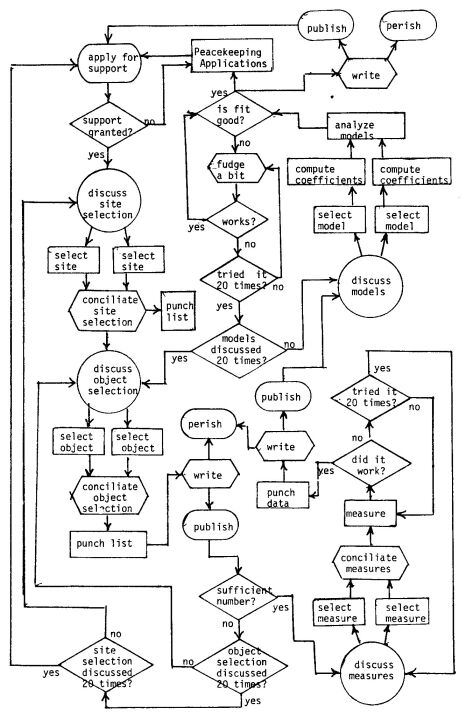Our Intrepid Instigator
Lays Down the Law Again
ON THE TENDENCIES
OF MOTION
Isadore Nabi
Harvard Colledge [1]

|
Our Intrepid Instigator ON THE TENDENCIES Isadore Nabi |
 |
In 1672 the first international conference on the trajectories of bodies was convened in order to organize a concerted systems approach to the problem of motion. This was made necessary on the one hand by the widespread observation that objects move, and on the other by the currency of extravagant claims being made on the basis of an abstracted extrapolation of the motion of a single apple. Practical applications related to our peacekeeping mission were also a consideration.
The organising committee realized that a unified interdisciplinary approach is required in which the collection of data must be looked at over as wide a geographic transect as possible, ancillary information must be taken without prejudice on all the measureable properties of the objects, multiple regression and principal factor analysis applied to the results, and the nature of motion then assigned to its diverse causes as observation and analysis dictate.
It was further agreed that where alternative models fit the same data both are to be included in the Equation by the delta method of conciliatory approximation.
Let M be the motion of a body as a function F (X1, X2 . . .) of the variables Xi (parametric variables of state, such as the location, velocity, mass, color, texture, DNA content, esterase polymorphism, temperature or smell of M) and let M1 = F1 (X1, X2, X3 . . .) be a model that fits the observations, and let M2 = F2 (X1, X2 . . .) be an alternate model that fits the data more or less equally well. Then (M1, M2) = δ F1 (X1, X2, X3 . . .) - (1 - δ) F2 (X1, X2, X3 . . .) is the conciliated systems model. The value of delta is arbitrary, and is usually assigned in the same ratio as the academic rank or prestige of its proponents. Similarly, when dichotomous decisions arose such as whether to include only moving objects or to allow those at rest in the regression, the alternate modes were both followed and then combined by delta conciliation (see block diagram).

Results
A total of 100,023 objects were examined, measured and used in the statistical analysis. From these we calculated 100 main effects, 49,500 pairwise interaction terms, 50,000 three‑way and 410 four‑way interaction coefficients, leaving 13 degrees of freedom for error variance. The data and coefficients have been deposited in the British Museum and may be published someday. Sample data are shown in Tables 1-1984 [2].
Some of the objects studied were Imperial Military Artifacts (IMA's) such as cannonballs. Since their tendencies of motion were similar to those of non‑IMA's and were independent of the nature of the target (the variance due to schools, hospitals, and villages all had insignificant F values), this circumstance need not concern us further. The IMA's were relevant only in that their extensive use in non‑cooperative regions (NCR's) provided data points which otherwise would have required Hazardous Information Retrieval (HIR), and that their inclusion in the studies prevented UnFinanced Operations (UFO's).
Conclusions
The motion of objects is extremely complex, subject to large numbers of influences. Therefore, further study and renewal of the grant are necessary. But several results can be reported already with the usual qualifications:
1. More than 90% of the objects examined were at rest during the period of observation. The proportion increased with size and in the larger size classes, decreased with temperature above ambient at a rate that increased with latitude.
2. Of the moving objects, the proportion moving down varied with size, temperature, wind velocity, slope of substrate if the object was on a substrate, time of day, and latitude. These accounted for 58% of the variance. In addition, sub‑models were validated for special circumstances and incorporated by the delta method in the universal equation:
(a) Drowning men moved upward 3/7 of the time, and downward 4/7.
(b) Apples did indeed drop. A stochastic model showed that the probability of apple drop increases through the summer and increases with the glucose concentrations.
(c) Plants tend to move upwards very slowly by growth most of the time and downward rapidly occasionally. The net result is mean tendency downward of about .001% ± 4%.
(d) London is sinking.
(e) A stochastic model for the motion of objects at Wyndam Wood (mostly birds, at the .01 level) shows that these are in fact in a steady state except in late autumn, with upward motion exactly balancing downward motion in probability except on a set of measure zero. However, there was extreme local heterogeneity with upward motion predominating more the closer the observer approached, with a significant distance X observer interaction term.
3. Bodies at rest remain at rest with a probability of .96 per hour, and objects in motion tend to continue in motion with a probability of .06.
4. For celestial bodies, the direction of movement is influenced by proximity to other bodies, the strength of the interaction varying as the distance to the ‑1.5 ±.8 power.
5. A plot of velocity against time for moving objects shows a decidedly non‑linear relation with very great variation. A slope of 32 feet/sec/sec is passed through briefly, usually at 1‑18 seconds after initiation of movement, but there is a marked deceleration prior to stopping, especially in birds.
6. For 95% ± .06 of all actions, there is a corresponding reaction at an angle of 175 ± 6° from the first, and usually within 3% of the same magnitude.
7. On the whole, there is a slight tendency for objects to move down.
8. A general regression of motion was computed. Space limitations preclude its publication.
9. In order to check the validity of our model a computer simulation program was developed as follows: the vector for velocity of motion V was set equal to the multiple regression expression for all combinations of maximum and minimum estimates of the regression of coefficients. Since we had a total of 100,010 such parameters, there were 2 to the 100,010 combinations tested, or about 1030000. For each of these, the error terms were generated from a normal random variable generator subroutine (NRBGS). Finally, a statistical analysis of the simulated motions is tested for consistency with the model. Computations are being performed by the brothers of the monastic orders, each working an abacus and linked in the appropriate parallel and serial circuits by the abbots. We have already scanned 105 combinations, and these are consistent with the model.
Acknowledgment
This work was supported by the East India Company.
Editor's Incidental Intelligence
[1] Who is Nabi? This question arose after a letter from Isadore Nabi appeared in Nature 19 Mar 1981 expressing confusion over recent contradictory statements by Richard Dawkins and Edward O. Wilson (who seem to be backwatering in their advocacy of genetic determinism as the result of criticism from the scientific community). The letter listed Nabi's address as Museum of Comparative Zoology, Harvard University.
Then 23 April came a letter from Edward O. Wilson, stating that the name Isadore Nabi is fictitious and making the claim that his (Wilson's) views on sociobiology and ethics had been distorted by Nabi. Wilson's address is also the Museum of Comparative Zoology at Harvard. Nature's editor responded: "Isadore Nabi is believed to be the pseudonym of Professor R. C. Lewontin of Harvard University." (Lewontin is on the faculty of the Museum of Comparative Zoology.)
Next (4 June) came a disclaimer from Isidore Nabi, University of Chicago, stating that he was not the "Isadore" who wrote the letter on genetic determinism.
Finally 25 June in Nature Richard C. Lewontin, hoping to throw "some light on the situation," wrote to "state categorically that any assertion that Isidore Nabi is none other than R. C. Lewontin is incorrect." He added that "Isidore Nabi is the author of several important works which, I am sorry to say, are not at all of my creation," mentioning particularly Nabi's "brilliant On the Properties of Motion" [sic] and the "seminal work An Evolutionary Interpretation of the English Sonnet."
New questions arise. What, for instance, is the significance of Lewontin's evident inability to spell the name Isadore correctly? And why did he apply a different title to the paper ("brilliant" indeed) published here under the heading: "On the Tendencies of Motion"? Should we ever meet Lewontin, we will ask why he failed to reference Science and Nature No. 3 where that first "seminal work" appeared. (We don't want to hide our Nabi under a bushel.)
POSTSCRIPT. The very latest is no less than an editorial in Nature (3 Sept 81) about a "nonexistent scientist, Dr. Isidore Nabi (whose first name is sometimes spelled Isadore)" created some years ago at the University of Chicago by "a group of scientists including Professor Leigh Van Valen (still at the University of Chicago), Dr. Richard C. Lewontin (now a professor at Harvard), and Dr. Richard Lester (now at the Harvard School of Public Health)."
"Unfortunately," says Nature, "the joke has gone too far . . . for example, a letter supposed to be from Nabi. was published in Nature (290, 183; 1981) making an otherwise plausible point . . . Nabi's name has turned up elsewhere, even as the author of articles in the journal called Science and Nature." The editors of Nature voice a twofold objection to use of a pseudonym in scientific literature: "First, it is a deception. Second, it. allows people with known opinions on important controversial matters to give a false impression that their opinions are more weighty than truth would allow."
We think the editors must have been a little groggy when they wrote that last sentence. And they may have gotten mixed up on names since "Richard Lester" seems more likely to be Prof. Richard Levins of Harvard Public Health who frequently coauthors papers with Richard Lewontin. But we are just plain indignant over their conclusion that "somehow Nabi has to be banished from the scientific literature." Let the editors of Nature recall the example of Nicolas Bourbaki, pseudonym for a group representing a respected though somewhat controversial viewpoint in mathematics. Nature is ready to bury Nabi without discussing the content of what he says (though we sent them a copy of Science and Nature No. 3). We, on the other hand, wish Nabi a continued productive career propounding a viewpoint that is useful to science and to society alike. Where the editors of Nature say "Isidore Nabi RIP," we say Long Live Nabi!
[2] These tables were not supplied by the author and we did not pursue the matter further.
SOURCE: Nabi, Isadore. “On the Tendencies of Motion,” Science and Nature, No. 4 (1981), pp. 62-66.
Note: Saul Birnbaum's two poems follow the Nabi article on the bottom of p. 66.
MaterialismMatter‑in‑motion |
DialecticsNo matter where we range |
|
— Saul Birnbaum, Bronx (N.Y.) Community College.
|
|
An Evolutionary Interpretation of the English Sonnet by Isadore Nabi
Science and Nature, Table of Contents, issues #1-10 (1978-1989)
Offsite:
The Nabi Papers by 'Isador Nabi'
Isidore Nabi on the Tendencies of Motion (from Levins & Lewontin, The Dialectical Biologist)
Isadore Nabi - Wikipedia, the free encyclopedia
Home Page | Site
Map | What's New | Coming Attractions | Book
News
Bibliography | Mini-Bibliographies | Study
Guides | Special Sections
My Writings | Other Authors' Texts | Philosophical
Quotations
Blogs | Images
& Sounds | External Links
CONTACT Ralph Dumain
Uploaded 26 May 2008
Links added 27 & 28 May 2008
Site © 1999-2008 Ralph Dumain